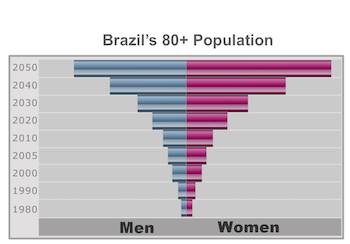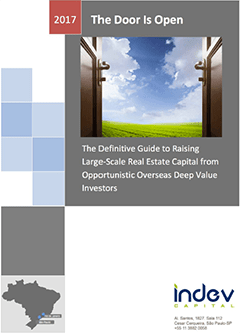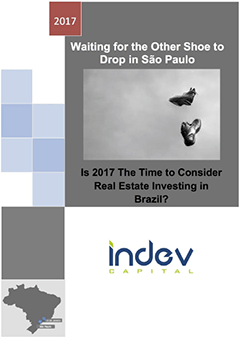
“Forever Young?” Not Really – Brazil´s Population Ages
What does a classic 80s rock song have to do with opportunistic senior housing real estate in Brazil? Forever Young is a wonderful concept. When I see the fun my two-year-old daughter has every day, I often wonder if I had as much fun in my own youth (probably, but I cannot remember). The song “Forever Young” was originated by a rock group named Alphaville. Subsequently, Mr Hudson, a talented musician, revitalized and immortalized the concept of forever young in pop culture with Jay Z in 2009 with their own “Forever Young” song.
“Forever Young” is a nice concept but is unfortunately not our reality. Brazil’s demographics are no longer “Forever Young.” How does this impact our deep value investment strategies? Can Brazil’s economic turnaround, record low interest rates, and a secular demand story create a unique high risk-adjusted return investment strategy?
A Unique Investment Opportunity Based on Brazil’s Aging Population
Purpose of This Newsletter
The purpose of this newsletter is to provide perspective of a unique opportunistic senior housing real estate investment opportunity based on demographic shifts and Brazil’s rapidly aging population. This rapid shift in demographics combined with a change in work/life patterns has created strong secular demand for Senior Housing. What is the opportunity? What currently exists in this sector? How does an investor make a large pile of money on this trade?
Demographics Are Changing Rapidly
 Image: Population distribution graphs from IBGE, Instituto Brasileiro de Geografia e Estatística. Click here for more interactive population graphs for the years 1980 to projected 2050.
Image: Population distribution graphs from IBGE, Instituto Brasileiro de Geografia e Estatística. Click here for more interactive population graphs for the years 1980 to projected 2050.
As shown by the above population pyramids, Brazil’s population is undergoing a demographic shift to an older population quite rapidly. The change in the shape of the population distribution from a pyramid in 2010 to a barrel in 2030 to almost an inverted pyramid in 2050 demonstrates an increasing life expectancy as well as a decreasing birth rate over the years.

As Bob Dylan rightly said in 1964, “The Times They Are A-Changin’.”
The improved life expectancy of Brazilians is clearly seen in the graph on the right, which shows a dramatic projected increase in the population of people 80 years old and above. This combination of an aging population and fewer children to take care of the elderly should have already created a boom in senior housing in Brazil. Why has this senior housing boom been delayed and what has changed?
WHY NOW for this Opportunistic Senior Housing Real Estate Investment Strategy?
Reason #1 – Where Are You From? Family Living Patterns
As an American in São Paulo, I am constantly asked where in the USA I am from. I always say with pride, The Great State of North Carolina; however, I also explain that in the USA, often where one is born is not necessarily connected to where one goes to college, where one decides to start a career, or where one lives the majority of one’s life. United States society is very mobile and adult children, particularly those with high income professional service careers, often live far from their parents.
In Brazil, it is not unusual for generations to live in the same neighborhood. Upper-class individuals with resources to live anywhere often grow up, study, work, and eventually die within 5 miles of where they were born in São Paulo. Why? First, culturally family units are tighter and there is not an almost mandatory event of “leaving home” for college among those with resources. Due to this close proximity to parents, there is often infrastructure or support networks among the children to take care of elderly parents.
Reason #2 – No Reason to Leave Home / Concentration of Opportunities
The second reason that Senior Housing has not taken off, at least for the larger cities of São Paulo and Rio de Janeiro, is that the large majority of the best educational, work, and social opportunities are concentrated in these large metropolitan areas. To my knowledge, Brazil has no Oberlin College (Oberlin is a top-tier liberal arts institution in Oberlin, Ohio, population 8500). Oberlin College is just one example among countless others of institutions in the USA that cause upper-middle class students to leave home, above and beyond the US national and research universities. This diversity of educational opportunities in the USA and Canada and in addition the diversity of job opportunities in other centers of business and commerce (Dallas, Atlanta, Seattle, Toronto, Montreal, etc.) does not exist in Brazil.
Hence, based on this concentration of opportunities, an upper-middle class person born in São Paulo is highly likely to stay in São Paulo for the rest of his or her life as this is where the best resources are and where his or her family resides. There is no reason to leave. This family geographic proximity based on concentration of opportunities is the second reason that senior housing was delayed. It is easier to monitor parents that live close by.
Reason #3 Female Workforce Participation
Women entering the workforce on a large scale in the 1970s in the USA created significant social changes. Obviously, daycare became more important and expectations that older parents had of their children upon aging changed. In the USA, it is not a stretch to say that there is little stigma in placing your parents in a high quality care unit because there simply are not other realistic alternatives. For most middle-income families in the USA, the cost of doing otherwise is prohibitive.
In Brazil, since 1975, female workforce participation in the formal economy (registered jobs with legally recognized work contracts) has increased from 30% to 44% according to IBGE, a public research institute. This significant increase has altered the role of caregiving in families. Traditionally, the wife would serve as the lead caregiver. As the female work participation rate has increased, this family-based caregiving is much more difficult to provide. Often, in cities such as São Paulo, to maintain an upper-middle income lifestyle, private healthcare, private school for children, other middle to upper-middle class pleasures (gym, international travel, etc.) requires two professional incomes. This female workforce participation changed the dynamics of being close to family as the core caregiver, or at least care manager, in the family is now no longer available full-time.
Reason #4 – Low-Cost Labor and Change in Labor Laws
Along with the cultural shift in workforce participation, a significant change in labor laws occurred. Unless you live in a cave (if so, you have an impressive internet connection), you are likely aware that Brazil has significant income inequality. Hence, even middle class people have domestic help to clean, and in some extreme cases upper-middle class families will have a full-time maid and a person that lives in the home to take care of the children. Due to the relatively high supply of low-skilled labor, until recently this was almost the norm for many upper-middle class families.
Much of this labor force originates from poorer, less educated areas of the country. Due to a large supply of such labor and a still large population of labor in poorer regions with a desire to move to wealthier areas like São Paulo and Rio de Janeiro, the supply demand ratio keeps wages for domestic help low. For example, until the change in labor laws, a middle class person could have a maid at a cost of R$1600 / month (approximately US$500) for 40 hours/week. This workforce was often unregistered and even if registered had no insurance, no vacation, no benefits, and no overtime, but was effectively full-time labor (not a great trade to be lower income in Brazil). This type of labor was available for nannying, adult home care, etc. Barring acute care needs, which we will discuss, the upper to middle class could fairly easily afford this level of domestic labor service.
Supplementary Law Number 150, enacted June 1, 2015
In 2015, labor laws changed with the enactment of Supplementary Law Number 150. At that point, any full-time domestic worker was due their respective wages and the benefits of a full-time salaried worker. These benefits are substantial: 13 months of salary per year, one month of paid vacation, a maximum of 8 hours of work a day with 1.5X times the rate for overtime, pension benefits, and unemployment benefits. Hence, the costs of this labor force has increased two-fold. As a result, full-time care at home is much more expensive and less available for upper-middle income families. This change in labor cost has worked its way through the system and has increased the costs of skilled care.
In summary, the Supplementary Law’s regulation that changed the cost benefit equation of home care, changes in workforce participation, the pattern of children staying close to parents throughout their lifetimes, and an aging population that is no longer “Forever Young” have combined to create a unique business opportunity.
The Opportunistic Senior Housing Real Estate Business Opportunity:
Sweet Spot and Pain Points
To build a profitable business in the senior housing space for Brazil requires focus on a niche of the market that has sufficient income to pay for full-time care at home but whose loved ones have reached a level of care that requires intense supervision and 24-hour/day care. It is at that point where families in Brazil have a hard look at alternatives. At this level of needed care, children feel that they are not providing the TLC (tender loving care) needed for the family member’s physical and psychological limitations. In technical terms, the target market is those individuals in need of skilled nursing care, Alzheimer’s care, and the continuing care niche.
Customer Description – Who is the Customer?
Individuals in Brazil that make ~R$20,000 per month, roughly US$6000, are a tight niche of ~1% of income earners. Importantly, while US$6000 per month will not do much in the USA, this level of income in Brazil can create quite a comfortable life for a family of four.
Families above this level generally have the following characteristics:
-
University-level education
-
Professional Career (business executive, lawyer, doctor, etc.)
-
Age 32 to 59
-
Second Home, International Travel
-
Children in Private School
-
Live in the best neighborhoods
-
Top private health insurance
Importantly for building a business, these families are easily reachable. They tend to have private health insurance from large local or international companies rather than use the public healthcare system, reside in the main capital cities of important states in Brazil, and go exclusively to first and second-tier hospitals.
Where the Senior Housing Market is Currently
The Senior Housing market is still in its early stages. The first real project, to your writer’s knowledge, was done by a group of nuns. It was developed in 2000. This served as the platform acquisition for Pátria’s Senior Housing platform Cora (Pátria is a large PE firm, 40% owned by Blackstone). Their platform, Cora, has seven locations and is focused on middle and upper-middle clientele. Pátria, with all due respect, is new to the business but is scaling its platform and has reached the seven units discussed above in 2.5 years.
Potential and Next Steps
Senior Housing has secular demand, latent demand, and limited competition. With a management team of local expertise and a US operator, this market has the opportunity for development yields significantly higher than what is available in developed markets. It has the potential to be a very interesting opportunistic real estate trade.
There are many remaining questions:
-
Are there actionable deals? Yes.
-
Are there local people with expertise to execute? Hard to find, but yes. We would not write this if we were not active in the trade 🙂
-
Is an international senior housing operator helpful? You bet!
-
Are the development yields opportunistic? Yes.
-
Are local real estate developer partners interested? Yes.
-
Is there a way to get more detailed information? For qualified and interested investors, sure!
To be clear, there is a lot to cover on this topic. This newsletter serves only as an introduction to a White Paper on Senior Housing for Qualified Investors and Senior Housing Operators. If you are an experienced qualified investor interested in learning more about this opportunistic real estate investment opportunity in Brazil’s Senior Housing market, please let me know such that you have access to our Senior Housing White Paper to be released shortly.
Finally, it is totally OK to play “Forever Young” at your next birthday party. I will play “Forever Young” as well so you are not alone.
A Very Belated Happy New Year and Happy Investing!
Joseph W. Williams





